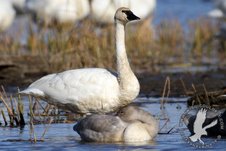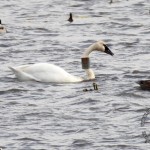
Al Stankovitz Photo of Tundra Swan and cignet
From Alan Stankevitz
Since the weather was so-so yesterday, I wasn’t planning on going down to Brownsville to photograph Tundra Swans but there was a break in the clouds so I headed down there for a bit. Upon my arrival it started to cloud over again (par for the course) but since I was there I decided to stick it out for a while and help answer people’s questions at the observation deck.
I was just about to leave when I spotted a banded Tundra Swan swimming amongst the other swans. This isn’t too unusual. I usually see a few banded swans every year. I report them to the USGS banding center and maybe if I am lucky, I get a response about a year later as to the history of the bird. On a whim, I also emailed a USGS employee who works with banding these swans.

Banded Tundra Swan
Within one hour I got a response from him with some rather interesting information regarding this bird. It was banded on July 26th of this year. It’s a male. And it was banded on the Buckland River Delta. Where is the Buckland River Delta? It’s in NW Alaska.
Usually the swans from this region follow the Pacific flyway. This one headed east over the Rockies and Canada. So far it has traveled over 3,000 miles and will more than likely overwinter along the eastern seaboard somewhere between Maryland and North Carolina. This will make its fall migration path close to 4,000 miles!!!
I then asked my contact to trace another swan seen by Dan Jackson on November 6 (photo above).. So far my luck hasn’t run out! T200 was banded on July 29, 2009 on the Colville River Delta on Alaska’s North Slope. It is not so unusual for swans in this area to head to the east coast via the Mississippi River Flyway.

We live on Cedar Lake, 3 miles outside of Star Prairie, WI 54026. Many swans on the lake saw a banded one number 47C. Interested in knowing the area it came from, approx. age, male/female,etc.